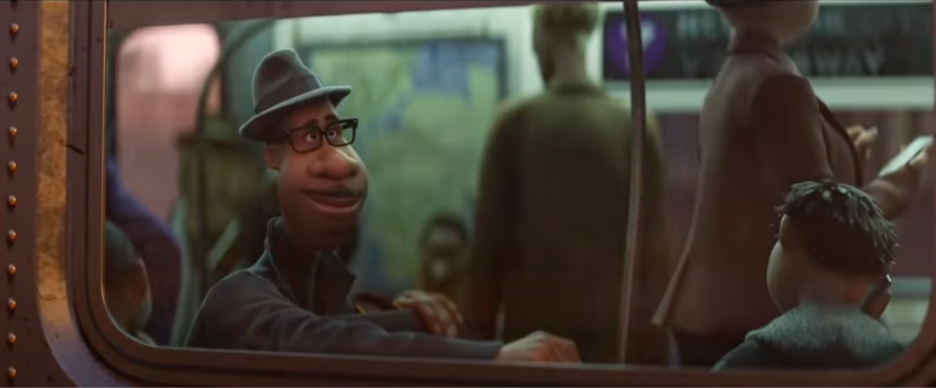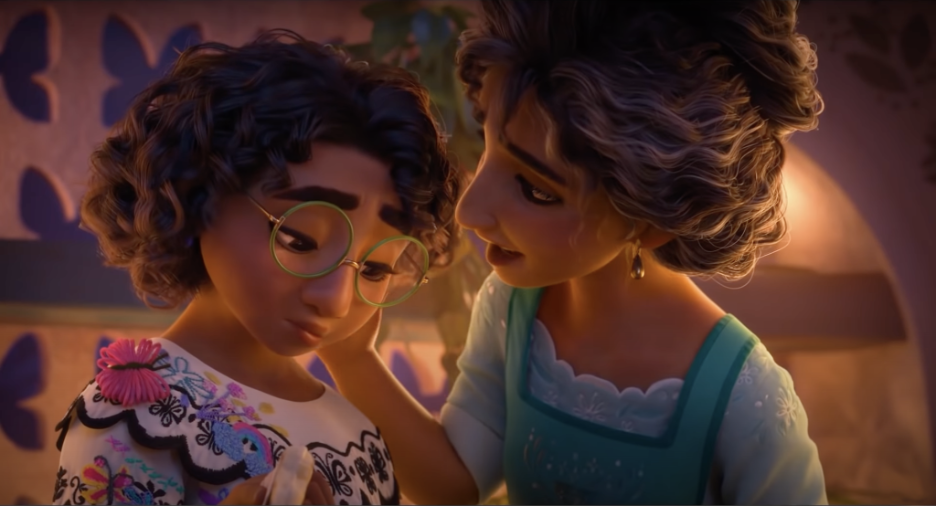One of the gifts of most faith-based communities is that they are among the few places in society where people of multiple generations gather together for meaning-making purposes. The task of pastors, rabbis, imams, or other leaders is to offer engaging worship and education experiences that speak to both 5-year-olds and 80-year-olds, a challenge made much harder during the COVID-19 pandemic. In December of 2020, as our faith community (the Hot Metal Bridge Faith Community, where Erin is pastor) was closing in on a year of Zoom worship and little other interaction, the Disney-Pixar film Soul (Doctor, 2020) came out. Many of our community members started posting about it on social media, reflecting on its themes of service, relationships, and mortality. Erin saw this and turned to her husband (Tim), the animation scholar, and said, “We could probably do a study on this, right?”.
Our particular community is no stranger to finding meaning in “secular” texts – we had watched and discussed the film Just Mercy (Cretton, 2019) just a few months before the pandemic. Many of the sacred reading practices Erin and HMBFC use are shaped by particular podcasts such as “Harry Potter and the Sacred Text,” as well as Ignatian Spirituality,[1] which invites imagination and looking “beyond” the words of scripture. In many ways, we were a community prepped and ready to take animation and its sacred lessons seriously.
We had a successful, inter-generational Zoom discussion about Soul in January of 2021, and then when Encanto (Bush and Howard, 2021) made an even bigger pop culture splash, we repeated the process. Those discussions have led both Erin and Tim to continue to think about animation as the basis for discussions of faith, family, and meaning-making. Below are lessons we gleaned from these first attempts at building community this way.
Applying Sacred Reading Practices to Animation. The intersection of pop culture and faith communities has mostly been concerned with what Evangelical Christians will and won’t watch. A growing corpus of work also concerns religious readings of films, and indeed “Faith and Film” classes prove popular at seminaries (see Kovlovic, 2006; Watkins, 2008). However, it is perhaps already clear that our particular faith community is far more comfortable with secular media texts than overtly “religious” ones, so we were more interested in the ways in which we could take sacred reading practices and apply them to animation texts for a cross-generational way to find meaning and community.
Erin is deeply shaped by Christian sacred texts but also pastors a community for whom those texts and traditions carry a lot of baggage. So as a community, we are intentional about how we engage texts and often turn to “secular” artifacts in order to find the “sacred” meaning we are searching for. In this way, our approach to animated films was shaped by what Vanessa Zoltan (2021) has said, “you need three things to treat a text [any text] as sacred: faith, rigor, and community.”
With Zoltan’s framework, any piece of text or media can be treated as sacred if you trust it has something meaningful to teach or reveal to you, you engage with it intentionally and with curiosity, and if you do it in community with one another. While engaging with animation is a different experience than reading an ancient text, our community approached these conversations with the expectation that these movies held meaning and lessons for us, that could only be revealed through engagement outside of passively watching them, and was richer for doing it together.
Soul – Death, Grief, and Antiracism. In many ways, Soul was an obvious choice for a Christian faith community to engage with as a text for spiritual engagement. The questions of life, death, and what comes next are often at the heart of an individual’s faith journey. And while Soul does not portray the afterlife in a way similar to that found in Christian scriptures, it does hit on themes of service and worthiness that resonated with our community, especially in the midst of a pandemic where many felt their mortality more keenly, and weren’t able to live into their gifts and talents as they once could.

One subject that resonated with the group was a shared discomfort with the racial presentation of cynical reluctant soul 22, voiced by Tina Fey. Participants voiced unease that the success and personal redemption of the first human African American Pixar protagonist depended on inspiration from a white comedic foil. These comments inspired Tim to quote Kara Andersen’s assertion from AnimationStudies2.0, that ”Characters not visually raced assume whiteness, since in Western culture white is the unmarked category and default” (2019). The group appreciated learning that this is an area of concern not only to anti-racist faith communities but to animation studies, asking, does casting Tina Fey make 22 white – regardless of what unseen body her soul may eventually inhabit?
Working through Generational Trauma with Encanto. A year later, Encanto captured our imaginations. Once again, social media posts and questions prompted our community to want to engage with one another around this text; though the themes shifted from death and antiracism to generational trauma and family dynamics.
For this particular Zoom gathering, we were fortunate to have a native Colombian be able to share her experience of the authenticity of the film, and its deep roots in the history of violence in Colombia. By allowing her experience to begin our discussion, the impact of trauma through generations and peoples was the central theme we grappled with as a group. We also intentionally invited the mental health therapist on staff at the church to be present and share her expertise on family systems and generational trauma.
The Bowen Family Systems Theory was created by Murray Bowen in the second half of the 20th Century, as a way to understand and categorize how humans behave and relate within an “emotional system.” For Bowen, the main conflict within an individual in a system is finding the balance between “individuality” and “togetherness.” This framework has been utilized in spiritual communities both for individuals to understand their own families, but also to understand congregational dynamics.

As we discussed Encanto as a group, we all had stories to share about our own family dynamics. Every family seemed to have a “Bruno,” whether a person or event or relationship, that was kept secret for far too long creating distance and isolation. We all had stories of an “Abuela,” a well-meaning, if too harsh matriarch or patriarch that was slow to come to terms with a changing structure in the family. Highlighting these sorts of stories and relationships in our own lives helped us find hope in the film’s conclusion.
Conclusion. Through these initial engagements with faith and animated films, we saw the possibilities for further application and conversation, in our small community and beyond. Erin was asked to present officially on Encanto and family systems theory at the judicatory level, and has begun to incorporate movies into her teaching and other activities. Tim, for his part, has made Erin write this blog with him as we continue to discern what this methodology might mean for animation studies and its application across disciplines. In each case, the answers we come back to are dialogue and ongoing community formation. We hope that by continually engaging with new and various media our community and beyond will be shaped in new ways.
References
Andersen, K. (2019) “Racialized Voice Acting and Transracial Voice Casting of Animated Animals” Animation Studies 2.0, 27 May, https://blog.animationstudies.org/?p=3074 (accessed Jan. 2023).
Bowen, M. (1984) Family Therapy in Clinical Practice. Rowman and Littlefield, Oxford.
The Enneagram Institute (2021). “The Traditional Enneagram” https://www.enneagraminstitute.com/the-traditional-enneagram (accessed Jan. 2023).
Kozlovic, A. K. (2006). “Film, Religion and Education in the Twenty-first Century: The Hollywood Hermeneutic”. Journal for the Academic Study of Religion, 19(1), 35-52.
Watkins, G. J. (2008). “Introducing Theories of Religion through Film: A Sample Syllabus.” Teaching Religion and Film, George Watkin (ed.) Oxford UP: 233.
Zoltan, V. (2021). Praying with Jane Eyre: Reflections on Reading as a Sacred Practice, Tarcher Perigee, New York.
Erin Jones is Pastor at Hot Metal Bridge Faith Community on Pittsburgh’s South Side. Her M.Div. is from Pacific Lutheran Theological Seminary, and she is an instructor on “The Art of Transitional Ministry” at Pittsburgh Theological Seminary.
Timothy Jones is Assistant Professor of Media Arts and Director of the Academic Media Center at Robert Morris University where he teaches courses in media culture and production. His research addresses inclusive education, production culture, craft distribution, and immersive stop motion.
Look for both Joneses as they launch Spirited Animation: The Podcast on the RMU Radio network, and wherever you get your podcasts.
[1] See Zoltan, Praying with Jane Eyre, 233-244 for a collection of sacred reading practices.
